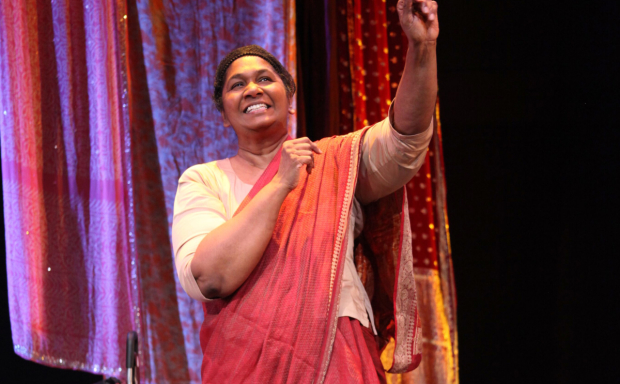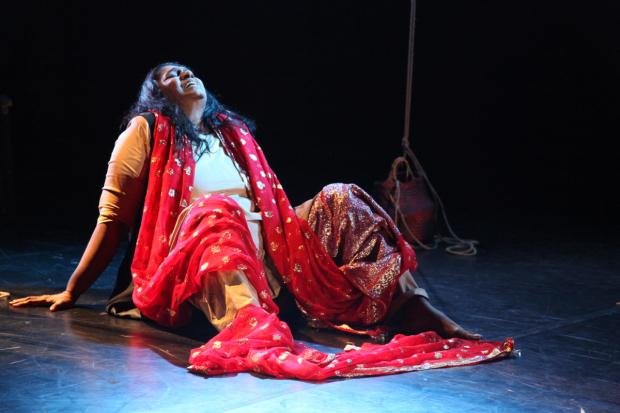Rani Moorthy: 'We deny curiosity of other cultures at our peril'

Since its inception in 1998, Rasa Theatre in Manchester has sought to celebrate and explore the universal migrant experience, touring their inventive, engaging and often challenging productions nationally and internationally. Their focus undoubtedly reflects the experiences of their artistic director, Rani Moorthy. Sri Lankan Tamil, she grew up in Malaysia, was educated in Singapore and moved to the UK in 1996. And her talents are as varied as her background; along with heading up Rasa, she writes for and acts on television, and her short film Incense has been shown in UK festivals as well as in Berlin, Cannes and New York.
Her latest show, Whose Sari Now?, a one-woman piece about the ideological complexities of the sari, and the part the garment plays in five characters’ lives, has just opened at Theatre Royal Stratford East after a national tour. We caught up with her to talk about the show, and why she's passionate about highlighting just how much we all have in common, whichever corner of the world we come from.
The show sounds like a captivating but complex beast. How did you come to write it?
I wanted to look at this garment [the sari], which has an entirely ritualised meaning, sensibility and aesthetic that comes from millennia-old notions of what you reveal, and what you hide. But I also wanted to look at it in terms of the migrant journey and story. When I came to live in Manchester, walking down curry mile in the mid-to-late nineties, you could see a glimpse of the end of a sari trailing along with the heavy winter coat. Then [more recently] I started to notice that it was no longer there. I rejected the sari for many years because it made me feel and look different in the gaze of other people, and I wondered whether that was the same for other second and third generation women. I wanted to look at these different characters who exemplify the many complex ideas we have about the sari – and by ‘we’ I mean South Asian women who are part of the diaspora.
And who are the five characters you play?
I start playing an 80 year-old women nearing death, who has sons and therefore no one to bequeath her precious saris to. I wanted to reflect the first generation because that voice often gets left out. Then there’s a transgender male who reflects on his childhood and the idea of being almost suffocated by the femininity of the sari. The third part I play in Tamil dialect with surtitles, because she’s a low-caste weaver. Even Asians in the audience wouldn’t know this aspect of the sari – that there are people somewhere in a little village working at an old 100-year-old loom, and they’re artists. Then there’s a Malaysian curator who has been overlooked for promotion because of her race. The only time any attention is paid to her is for the Bollywood and the sari exhibitions. And then a Sri Lankan Tamil girl who’s giving birth in the middle of a Sri Lankan war zone.
How have your own experiences shaped your writing?
This show stems from my life being a minority within a minority; growing up Sri Lankan Tamil in a small community in Malaysia; affected by race riots when I was very young. It’s a multi-cultural, multi-racial country but all the things we’re experiencing right now with Brexit and with what Trump is saying happened in my own life when I was a child; neighbours turning against you because you’re different. My parents wanted us educated in English so every day I took a passport across the bridge and crossed the border into Singapore. I hope a lot of this resonates in the sense of what’s happening right now in the world.
Carrying a show on your own can be a tough gig, as can working alone with a director. How have you found it?
It’s intense because it’s a whole range of emotions and there’s no let up. But Kimberley [Sykes, the director] brings attention to detail and an interesting look at the text, because she sees it as a work of literature, not just a play script. It’s exciting [carrying the show] because you write it and you think you’re not playing with any other characters. But firstly the audience is your other character, then each character comes with a backstory that I have worked on, so I know that I’m not entirely alone when I play this woman.

Are we still woefully lacking British theatre created by and about women?
I think women are always writing and they’re writing everywhere. But it’s who gets the attention. Women are writing good, solid stuff but we’ve got the same writers. I’m not saying they're not good but I’m saying they’re getting the same attention. And that’s across the board [for] women in general. You can get a handful of women who win prizes and who are given great opportunities in big theatre. And then you look at women of colour and diversity and you’re in trouble because there’s no one who’s consistently at the top.
What are you hoping the show will achieve?
My main impetus behind writing the piece was that these are narratives generally left out in the British stage. These characters who appear 'different' or 'quirky' – you can use whatever adjective you want – they’re the persons that you will be shocked and surprised [to find things in common with] if only you were curious enough about the human condition and the human race. We deny our curiosity, and we do it at our peril. I want to peek into the room of a person that we ignore because we think they’re not part of our world.
Some might argue that recent political events have created an upsurge in that sort of thinking…
There are all sorts of psychological reasons [we think in that way] and, these days, there are really bad, definite reasons. We’re bombarded with that concept of ‘let’s just get rid of the other and keep us all in this weird world that we think is from the past'. I figure once people have the impulse to buy the ticket, for whatever reason, it means that they’re curious. And then maybe halfway through I hope one or two will think, 'actually that’s not so different. I felt like that. I wore my prom dress and I felt how she felt.'
How have audience reacted on the tour so far?
Somebody said that it’s messy in a nice way, which I thought was really interesting because it is. I’m not going to give you the answers, all I’m trying to do is look at very complex characters and try and make people laugh and hopefully think about them in a useful way. I’d like to add, it all sounds a bit worthy, all of this, but I do like to make people laugh at things because I think it really unifies all of us.
How were you bitten by the theatre bug?
In Kindergarten I got teased for being bigger and taller than everybody else. I wasn’t one of the popular kids. Then when I was five there was a proper band for the school’s end-of-year concert, and they said would somebody like to come up and sing something. And something told me 'OK – all the other kids have to stand on a chair to reach the microphone. Well I don’t have to do that because I’m taller than everybody else.' So I went up there and started singing 'Doe, Re, Mi' (not well) and the band followed me. And I thought, 'God this is very powerful.' So that was it.
Whose Sari Now? runs at Theatre Royal Stratford East until 17 December.










